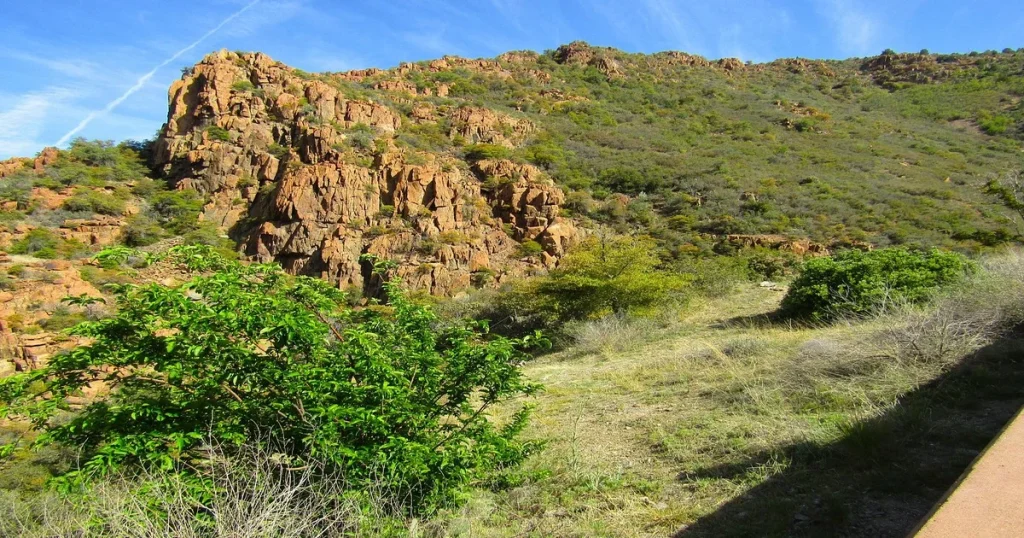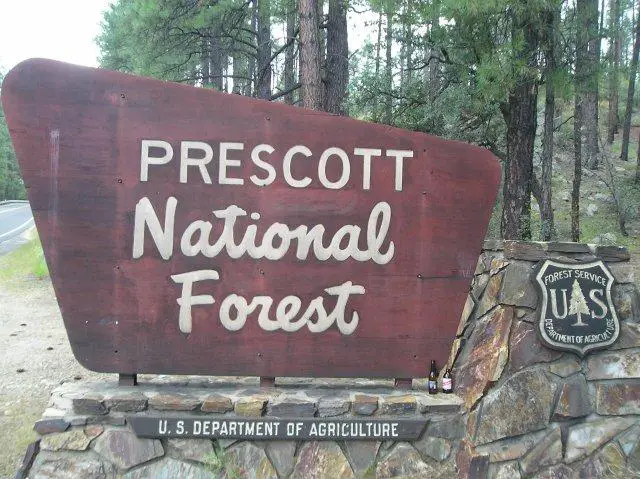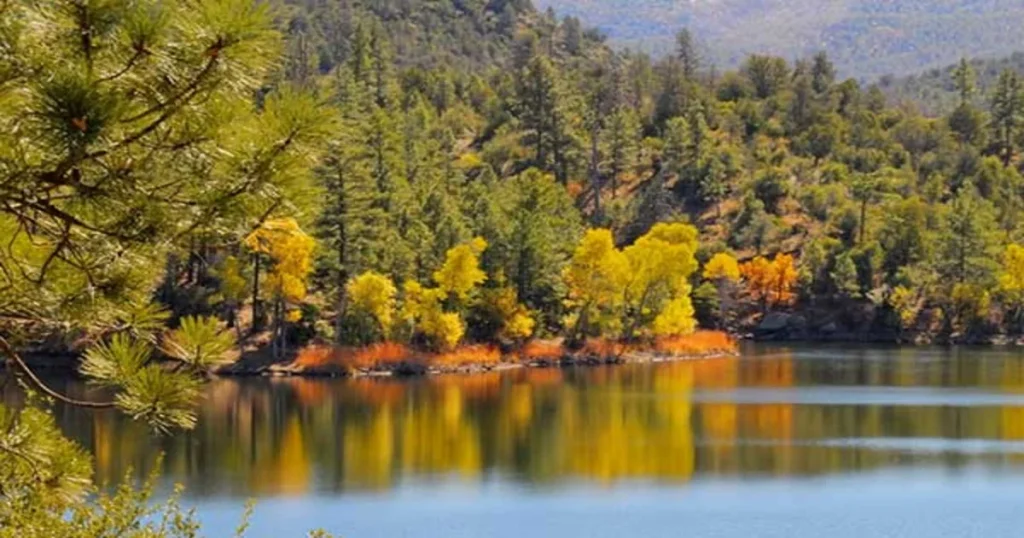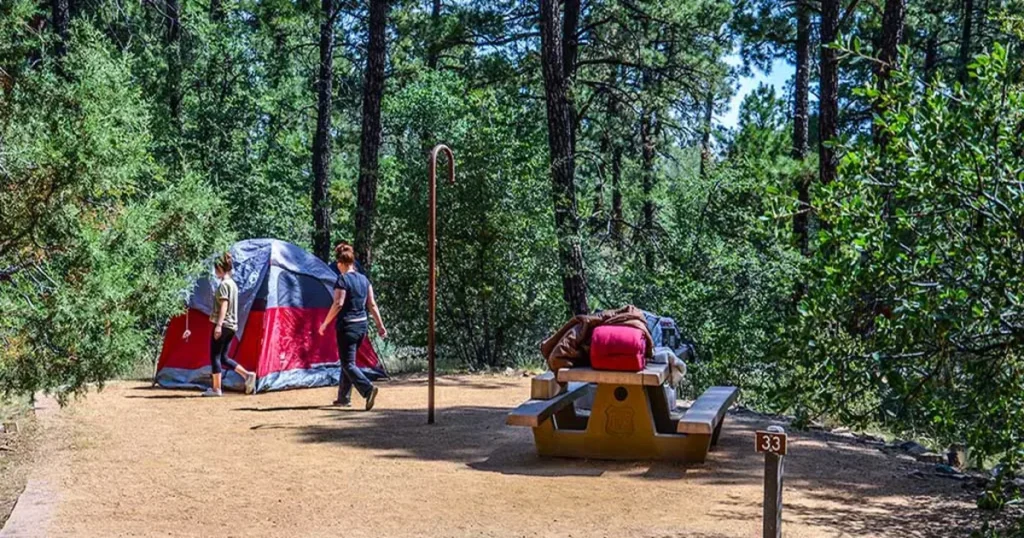Prescott National Forest is an awe-inspiring gem, boasting diverse landscapes and rich biodiversity. For those who appreciate nature, it offers an unparalleled hiking experience. Yet, like all wilderness areas, it requires visitors to tread with caution.

Following the Prescott National Forest trail safety guidelines ensures not just one’s safety but also the preservation of this precious ecosystem for future generations.
Understanding the Forest’s Unique Terrain
The Prescott National Forest is not just a haven of natural beauty but also a mosaic of unique terrains that have evolved over millennia. Navigating through its vast expanses requires a deep understanding of the diverse topographical challenges it presents.
From dense woodlands with hidden roots and uneven ground to rocky outcrops that test one’s balance and agility, the forest showcases a plethora of landscapes. Marshy areas may demand waterproof footwear, while steep inclines call for sturdy boots with good ankle support.
Recognizing the subtle cues of the terrain, like the shift from soft soil to gravel, can be crucial in anticipating potential challenges. Knowledge of this intricate terrain is not just about enhancing the hiking experience; it’s about ensuring every step taken is a safe and informed one.
Topographic Diversity of Prescott National Forest
The forest is a tapestry of rolling hills, steep inclines, dense thickets, and open grasslands. Such diversity means that trail conditions can vary widely, even within the same hike.
Before embarking on a trail, it’s crucial to understand its specific characteristics, ensuring you’re adequately prepared for the challenges it might present.
Ecosystem Variations and What They Mean for Hikers
Different ecosystems house varied flora and fauna. For instance, meadows might seem benign, but they can house burrowing creatures or become muddy and treacherous after rains. Wooded areas might offer shade but can also be home to insects or larger wildlife that hikers should be wary of.
Familiarizing oneself with these ecosystems is key to a safe hiking experience. More on Ecosystem Variations
Seasonal Considerations for Safe Exploration
Exploring the wonders of nature, such as those within the Prescott National Forest, offers different experiences and challenges with each changing season. Seasonal considerations become crucial touchpoints for any hiker’s safety checklist.
In the spring, melting snow can make trails slippery and rivers treacherous. Summer, with its warmth, beckons many but also brings with it the risk of heatstroke and the need for extra hydration. Autumn, with its tapestry of colors, might hide uneven terrains beneath fallen leaves, while winter’s snow and ice demand specialized gear and heightened awareness of shortened daylight hours.
Each season, with its distinct beauty, also serves as a reminder of nature’s ever-changing temperament, emphasizing the need for tailored preparation and caution.
Winter: Snow and Icy Trail Conditions
Winter transforms the forest into a winter wonderland. Yet, snow and ice can make trails slippery. It’s essential to wear shoes with good traction and perhaps consider carrying ice grippers.
Moreover, be mindful of shorter daylight hours; starting hikes early ensures you’re back before dark.
Spring: Melting Snow and Trail Washouts
Spring is a time of renewal. Melting snow can cause trails to be wet, muddy, or even washed out. It’s essential to check trail conditions before heading out. Avoid walking on muddy trails as it can cause erosion.

If you encounter water flowing across trails, tread carefully. Trail Conditions Update
Summer: Heat and Monsoon Challenges
Summer is beautiful but can be deceptively dangerous. High temperatures necessitate carrying ample water and avoiding midday hikes. Monsoons bring their challenges, with sudden rain showers and potential flash floods. Always be aware of weather forecasts.
Fall drapes the forest in a golden hue. Fallen leaves, while scenic, can hide trail obstacles or make paths slippery. Hikers should tread carefully, ensuring they have a clear footpath.
Basic Hiking Safety Principles
Setting out to explore the trails of any wilderness area, including the Prescott National Forest, demands a foundational understanding of basic hiking safety principles. At the core of every successful hike is the blend of preparation and awareness. Prior to departure, researching the chosen trail, understanding its challenges, and checking weather forecasts are indispensable steps.
Equally important is equipping oneself with essentials like maps, a compass, and adequate water. On the trail, adhering to marked paths, avoiding unnecessary risks, and being vigilant of one’s surroundings are vital. Regularly checking in with a buddy or notifying someone of your route and expected return time can be lifesaving.
In essence, safety in hiking is as much a mindset as it is a practice, where respect for nature’s unpredictability meets thorough preparation.
Plan Ahead and Be Prepared
- Always research the trail beforehand.
- Inform someone about your hiking plans and expected return time.
- Pack essential items, including maps, snacks, water, and first-aid supplies.
Always Hike with a Buddy
Solo hikes might seem enticing, but there’s safety in numbers. If something goes wrong, having someone with you can make a significant difference.
Prescott National Forest has clearly marked trails. Straying from them can lead to getting lost or inadvertently damaging the ecosystem. Prescott National Forest Trails
Wildlife Interactions: Safety and Respect
The forest is teeming with wildlife, from benign creatures like deer and rabbits to potentially more dangerous animals like bears and snakes.
While encounters with bears or mountain lions are rare, they’re not unheard of. Always be alert and aware of your surroundings. Making noise, especially when visibility is limited, can alert animals to your presence and prevent surprising them.
Best Practices When Encountering Wildlife
If you encounter wildlife:
- Keep a safe distance.
- Never feed them; it’s harmful and can make them aggressive.
- If you encounter a larger animal, avoid direct eye contact, speak calmly, and slowly back away.
Every visitor plays a role in protecting Prescott National Forest. Leaving no trace ensures that we don’t harm the habitats of the animals that call this forest home. Simple acts, like not leaving food behind or picking up trash, can make a difference.
Personal Protective Equipment for Hikers
Embarking on a hike in the Prescott National Forest is not just about embracing the wild; it’s about equipping oneself to meet its challenges head-on. Personal Protective Equipment (PPE) for hikers serves as a shield against the unpredictable elements of nature.
From sturdy footwear that grips rugged terrains to sunglasses that fend off harmful UV rays, each piece of PPE has its unique role in ensuring safety. Layered clothing can shield against sudden temperature drops, while hats and gloves might ward off potential hazards.
In essence, arming oneself with the right PPE is like having a silent companion, always at the ready to safeguard against the unforeseen.
Essential Hiking Footwear for Varied Terrains
Good footwear is paramount. Choose hiking boots or shoes that offer:
- Excellent ankle support, especially if tackling rough terrains.
- A solid grip to ensure stability on slippery or uneven paths.
- Waterproofing, especially if you anticipate crossing streams or hiking during wet conditions. Choosing the Right Hiking Boots
Importance of Weather-appropriate Attire
Adapting to the forest’s diverse climate requires weather-appropriate clothing:
- Layering is key. It allows you to adjust according to temperature changes.
- Opt for moisture-wicking fabrics to keep sweat at bay.
- Always carry a lightweight rain jacket, even if the forecast is clear.
Protective Gear: Hats, Sunglasses, and Trekking Poles
Protecting yourself against the sun and potential obstacles is crucial:
- Wide-brimmed hats shield against sunburn.
- Polarized sunglasses protect the eyes from harmful UV rays.
- Trekking poles can provide added stability, especially on challenging terrains.
Staying Hydrated and Nourished
Navigating the diverse trails of Prescott National Forest demands more than just physical stamina; it requires a commitment to staying hydrated and well-nourished. As the body exerts energy, replenishing lost fluids and nutrients becomes crucial. But it’s not just about quantity—it’s about timely intake and quality choices.
Carrying sufficient water, understanding signs of dehydration, and packing nutrient-rich snacks are the cornerstones of a healthy hiking experience. In the midst of nature’s grandeur, ensuring one’s well-being by prioritizing hydration and nutrition is an essential aspect of the journey.

How Much Water to Bring and How to Store It
A general recommendation is to drink half a liter of water per hour of moderate activity in moderate temperatures. However, this amount can vary based on individual needs and weather conditions.
Always carry more water than you anticipate needing. Using insulated bottles can help keep your water cool. Stay Hydrated While Hiking
Nutritional Snacks for Sustained Energy
Pack energy-rich snacks like:
- Trail mix comprising nuts and dried fruits.
- Energy bars.
- Peanut butter sandwiches for sustained energy release.
Recognizing Signs of Dehydration
Be alert to signs of dehydration:
- Thirst or dry mouth.
- Dark yellow urine.
- Fatigue or dizziness.
- Dry or cool skin.
First Aid and Emergency Situations
Venturing into the vast expanses of the Prescott National Forest underscores the importance of being prepared for the unforeseen. Even the most seasoned hiker can encounter challenges. First aid and emergency preparedness are not just optional precautions but essential components of a successful hike.
Equipping oneself with a well-stocked first aid kit and knowledge of basic wilderness first-aid can make the difference between a minor hiccup and a major crisis. While the forest’s beauty captivates the senses, a proactive approach to safety ensures that explorers can fully savor their adventure with peace of mind.
Must-have Items in Your First Aid Kit
Ensure your kit contains:
- Band-aids and bandages of various sizes.
- Antiseptic wipes.
- Tweezers for splinters or ticks.
- Pain relievers and any personal medications.
- Blister treatment pads.
Common injuries like sprains or blisters can be addressed with basic first-aid knowledge. Always consider taking a wilderness first-aid course; it can be invaluable. Wilderness First Aid Basics
Protocol for Seeking Emergency Assistance
If faced with a situation beyond your control:
- Stay calm and assess the situation.
- Use a whistle or mirror to signal for help.
- If you have cell service, dial emergency services.
Modern technology has undoubtedly made navigation more accessible, but relying solely on it can be perilous. Traditional navigation tools, coupled with tech, ensure you stay on the right track.
Maps give a bird’s eye view of the terrain, while a compass provides direction. Together, they’re invaluable, especially if technology fails. Learn to read topographic maps and use a compass to pinpoint your location. Learn Map & Compass Navigation
Utilizing GPS and Smartphone Apps Responsibly
While GPS devices and apps like AllTrails are incredibly helpful, always have a backup, like a physical map and compass. Ensure your devices are fully charged, and consider carrying a portable charger.
Despite the allure of technology, the skills of traditional navigation remain essential. They don’t rely on battery life and offer a deeper connection with the surroundings.
Camping in Prescott National Forest
Camping amidst the serene landscapes of Prescott National Forest is an immersive way to connect with nature. As the canopy of stars envelops the night and the forest’s nocturnal symphony begins, campers are transported to a world away from urban chaos. However, this rustic experience also demands a sense of preparedness and respect for the environment.
Whether it’s selecting a safe campsite, responsibly managing campfires, or being alert to wildlife, every decision should be made with both personal safety and environmental preservation in mind. Such mindful camping ensures memorable experiences without compromising the forest’s natural splendor.
Choosing Safe Campsites
Selecting a good campsite is more than just about the view:
- Avoid areas prone to flooding, especially near water bodies.
- Stay away from cliff edges or unstable ground.
- Ensure you’re at least 100 feet away from lakes and streams to protect riparian areas. Leave No Trace Camping
Campfires: Safety and Regulations
While campfires are a quintessential part of the camping experience:

- Always check if campfires are allowed. Drought conditions might impose bans.
- Use established fire rings or portable camp stoves.
- Ensure your fire is fully extinguished before leaving or sleeping. Campfire Safety Tips
Wildlife Awareness while Camping
Nighttime can increase wildlife activity:
- Store food securely to not attract animals.
- Use bear-proof containers where required.
- Be vigilant and use a flashlight when moving around at night.
Group Hiking: Coordination and Safety
Group hiking in areas like Prescott National Forest is both a rewarding communal experience and a venture that requires meticulous coordination. The synergy of shared memories on the trail is matched by the importance of ensuring each member’s safety.
Effective communication, clear roles, and shared responsibilities within the group become pivotal. By embracing a collective approach where experienced hikers guide the less seasoned and decisions are made with everyone’s comfort in mind, group hikes can seamlessly blend the joy of companionship with the assurance of safety.
Sticking Together: Importance of Group Cohesion
It’s easy for groups to get separated, especially in challenging terrains or during breaks:
- Establish regular checkpoints to regroup.
- Assign a lead and sweep to ensure no one gets left behind.
- Encourage open communication about comfort levels and pace.
Benefits of Varied Skill Levels in a Group
Diversity in hiking experience within a group can be beneficial:
- More experienced hikers can guide and mentor newer ones.
- Varied skill sets can come in handy in unpredictable situations.
- Sharing of equipment and resources can reduce individual loads.
Communicating Clearly: Setting Expectations and Boundaries
Clear communication ensures everyone’s on the same page:
- Discuss the trail’s difficulty level and ensure everyone’s comfortable.
- Establish ground rules, like staying on the trail or respecting nature.
- Check-in frequently, especially if members are new to hiking.
Environmental Responsibility: Protecting Prescott National Forest
Environmental responsibility while exploring Prescott National Forest is not just a courtesy, it’s a duty. As visitors to this natural haven, it’s essential that we minimize our impact, preserving the forest’s pristine beauty for future generations.
By adhering to eco-friendly practices, respecting the flora and fauna, and actively reducing waste, we ensure that the forest remains a vibrant ecosystem, brimming with life and wonder. Adopting a “leave no trace” mindset guarantees that our adventures are harmonious with the environment, fostering a symbiotic relationship with nature.
Minimizing Waste and Proper Disposal
Every piece of trash has an impact:
- Carry all trash out with you. Leave no trace.
- Use biodegradable soaps if washing is necessary.
- Avoid single-use plastics. Reusable containers are both eco-friendly and often more efficient for hiking. Minimizing Camp Waste
Respecting Flora and Fauna
The forest’s flora and fauna are sensitive to human interference:
- Stick to trails to avoid trampling on plants.
- Don’t pick flowers or plants.
- Observe wildlife from a distance. Remember, you’re in their home.
Reporting Environmental Damages or Concerns
- If you notice damages or issues that could harm the forest:
- Report them to the Prescott National Forest ranger station or the nearest authority.
- Avoid trying to rectify damages yourself, as it could lead to further harm.
Frequently Asked Questions:
In this section, we will be delving into some of the most common inquiries and curiosities that surround our topic.
Are There Any Trails Off-Limits for Safety Reasons?
Yes, certain trails might be closed due to maintenance, wildlife activity, or after severe weather. Always check trail updates before embarking on your hike.
What Do I Do If I Get Lost in the Forest?
Stay calm. If you have a whistle, blow it. It’s often easier for rescuers to locate you if you stay put. If you have cell service, call for help.
How Can I Report a Safety Concern or Hazard on the Trail?
You can report concerns to the Prescott National Forest ranger station. They’ll guide you on the necessary steps.
Are Drones Allowed in Prescott National Forest?
Drones might be restricted in certain areas to protect wildlife or due to other concerns. Always check the official guidelines before flying a drone.
How Can I Stay Updated on Current Trail Conditions?
Regularly checking the official Prescott National Forest website or trusted hiking forums can provide the most up-to-date trail conditions.
Summary: Hiking with Confidence and Care
Prescott National Forest is a haven for nature enthusiasts. Its expansive trails and diverse ecosystems offer an experience like no other. By adhering to the trail safety guidelines, hikers can ensure a safe and enjoyable journey.
Let’s cherish and protect this gem by treading responsibly and leaving no trace behind. Safe hiking!



Leave a Comment
You must be logged in to post a comment.